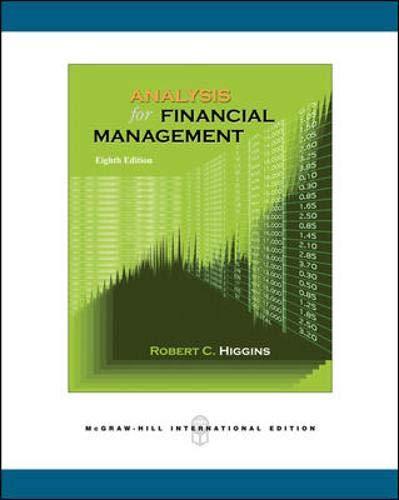Evaluate the performance of Community National Bank relative to peer banks using the data in Exhibits 3.2, 3.4, 3.7, 3.8, and 3.9. Did the bank perform above or below average in 2013? Did it operate with more or less relative risk?
a. Conduct a return on equity decomposition analysis for 2013, identifying where the banks performance compared favorably and unfavorably with peer banks?
b. Compare the banks risk measures with those of peer banks. What are the implications of any significant differences?
c. What recommendations would you make to adjust the banks risk and return profile to improve its performance?








EXHIBIT 3.2 2012-2013 Balance Sheet Information for PNC Bank and Community EXHIBIT 3.2 (continued) EXHIBIT 3.4 2012-2013 Income Statements of PNC Bank and Community National Bank EXHIBIT 3.4 (continued) EXHIBIT 3.7 Supplemental Operational and Loan Data for PNC Bank and Community National Bank, 2012-2013 EXHIBIT 3.8 Profitability Measures for PNC Bank and Community National Bank, 2012-2013 The equity multiplier (EM) is obtained from equation 3.8 by solving for EM; "aTA" is average total assets from Exhibit 3.7. For consistency with the UBPR page 6, however, all "mix" or composition values use averages of current and prior period. For example, numerator and denominator averages for "Total deposits (avg.)/aTA" are both calculated using end-of-period annual average data. Note: Short-term noncore funding from March 31, 2011 forward equals the sum of time deposits of more than $250,000 with a remaining maturity of one year or less + brokered deposits issued in denominations of $250,000 and less with a remaining maturity of one year or less + other borrowed money with a remaining maturity of one year or less + time deposits with a remaining maturity of one year or less in foreign offices + securities sold under agreements to repurchase and federal funds purchased. Prior to March 31, 2011 the definition used deposits of $100,000 or more. Due to the lack of detailed data, calculated volatile liabilities does not include brokered deposits. Often, an analyst must dig deeper into the actual credit files, the footnotes to the balance sheet, and any off-balance sheet activities to discover risk not reported on these financials. With this said, the section of this chapter titled "Financial Statement Manipulation" will discuss the analysis of reported financial statements, with the understanding that the analysis is only as accurate as the reported data. Selected risk ratios for PNC and CNB appear in Exhibit 3.9. Additional data used to calculate some of the risk ratios, including loan charge-offs, past-due loans, and noncurrent loans are taken from the supplemental data in Exhibit 3.7 and the UBPR for PNC included in this chapter's appendix. Exhibit 3.9 lists selected risk measures categorized under the risk types introduced earlier. Cvuldut 2 Q (mantinnanl SearchEngine/Default.asp. EXHIBIT 3.2 2012-2013 Balance Sheet Information for PNC Bank and Community EXHIBIT 3.2 (continued) EXHIBIT 3.4 2012-2013 Income Statements of PNC Bank and Community National Bank EXHIBIT 3.4 (continued) EXHIBIT 3.7 Supplemental Operational and Loan Data for PNC Bank and Community National Bank, 2012-2013 EXHIBIT 3.8 Profitability Measures for PNC Bank and Community National Bank, 2012-2013 The equity multiplier (EM) is obtained from equation 3.8 by solving for EM; "aTA" is average total assets from Exhibit 3.7. For consistency with the UBPR page 6, however, all "mix" or composition values use averages of current and prior period. For example, numerator and denominator averages for "Total deposits (avg.)/aTA" are both calculated using end-of-period annual average data. Note: Short-term noncore funding from March 31, 2011 forward equals the sum of time deposits of more than $250,000 with a remaining maturity of one year or less + brokered deposits issued in denominations of $250,000 and less with a remaining maturity of one year or less + other borrowed money with a remaining maturity of one year or less + time deposits with a remaining maturity of one year or less in foreign offices + securities sold under agreements to repurchase and federal funds purchased. Prior to March 31, 2011 the definition used deposits of $100,000 or more. Due to the lack of detailed data, calculated volatile liabilities does not include brokered deposits. Often, an analyst must dig deeper into the actual credit files, the footnotes to the balance sheet, and any off-balance sheet activities to discover risk not reported on these financials. With this said, the section of this chapter titled "Financial Statement Manipulation" will discuss the analysis of reported financial statements, with the understanding that the analysis is only as accurate as the reported data. Selected risk ratios for PNC and CNB appear in Exhibit 3.9. Additional data used to calculate some of the risk ratios, including loan charge-offs, past-due loans, and noncurrent loans are taken from the supplemental data in Exhibit 3.7 and the UBPR for PNC included in this chapter's appendix. Exhibit 3.9 lists selected risk measures categorized under the risk types introduced earlier. Cvuldut 2 Q (mantinnanl SearchEngine/Default.asp














